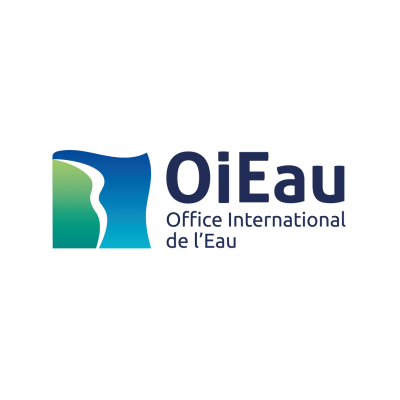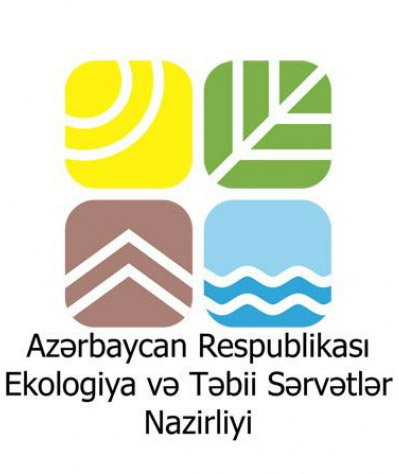| Ekoportal |
|---|
|
|
Water supply
A brief summary
In 2017, 50.9% of the total population of Azerbaijan was connected to the centralized water supply system. The number of people connected to the water supply industry increased by 9.3% in 2017 compared to 2005. In absolute terms, the total population connected to the communal water supply network increased by 41.6% during the same period. Water losses during transportation have remained a major concern in the water supply sector. In 2019, 42.7% of the total water supply was lost during water transportation.
Is the access percentage of Azerbaijani citizens to water supply services increasing?
Population connected to the water supply industry (2005-2017)

Net volume of water supplied by the water supply industry and losses during transport (2005-2019)
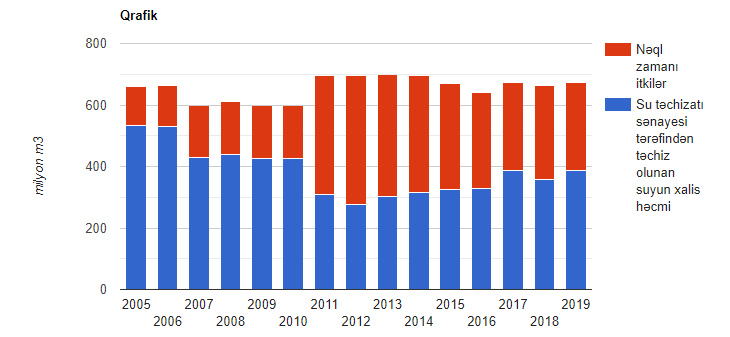
In 2019, 673.7 million m 3 of water was supplied through the water supply system, of which 287.35 million m 3 was lost in the water supply network, which is equal to 42.7% of the total supplied water. Total supplied water increased relatively between 2005 and 2019 (2.1%). At the same time, net water consumption per person has decreased significantly from 150 m 3 /year in 2005 to 54.6 m 3 /year in 2017 . However, due to the increasing share of water losses, the total water supply has decreased.
In 2005, only 41.6% of the population was connected to the centralized water supply system. As a result of the investments made in the water transportation system and the implementation of water supply projects, the share of the population connected to the water supply system has increased to 50.9% of the total population of the country. At the same time, the absolute number of people connected to water supply also increased significantly from 3.6 million people in 2005 to 5 million people in 2017. However, in the near future, these major water issues will continue to be of concern: (1) an increase in the percentage of the total population connected to the municipal water supply system; and (2) reducing leaks in the water conveyance system. Work on both of these problems should be continued with financial and technical investments in the municipal water supply network. Despite all of this, up to half of the population still has to meet their water needs through self-supply. This keeps Azerbaijan far from the United Nations (UN) Sustainable Development Goals (SDG) target 6.1, achieving universal and equal access to safe and affordable drinking water for everyone by 2030.
Features of the indicator
Description of the pointer
This indicator presents the volume of water supplied to consumers by the water supply industry, taking into account water losses during water transport and the population connected to the water supply industry, both in total number and as a percentage of the total population.
Units
The total volume of water supplied by the water supply industry is measured in million cubic meters per year; and the share of the total population connected to the water supply industry is shown as a percentage.
Justification
Rationale for indicator selection
The indicator is important for determining the level of development of water management services and the degree of access to water to meet the needs of the population. The indicator also helps identify trends in water supply.
Scientific references
- UNECE, 2011. Azerbaijan - Second Environmental Performance Review, United Nations Economic Commission for Europe, Environmental Performance Review Series No. 31, e-ISBN 978-92-1-117035-1, New York and Geneva.
- UNECE, 2018. Guidelines for the Implementation of Environmental Indicators, description of C5: The water supply industry and the population connected to the water supply industry.
- UNECE, 2018. Guidelines for the Application of Environmental Indicators, Glossary of Terms – C5: Water supply industry and population connected to the water supply industry.
Political context and objectives
A description of the context
National political context
The Water Code of the Republic of Azerbaijan (1997) was adopted by the Law No. 418-IQ of the Republic of Azerbaijan dated December 26, 1997. The part of the Caspian Sea (lake) belonging to Azerbaijan is part of the natural wealth of the Azerbaijani people and is used and protected as the basis of life and activity of the population and to ensure the existence of flora and fauna. The Code regulates the legal rules in the field of using and protecting water bodies in Azerbaijan.
International political context
Sustainable Development Goal 6 (SDG 6) of the UN's 2030 Agenda for Sustainable Development is to "ensure access to water and sanitation for all". Goal 6.1 of SDG 6 also aims to “achieve universal and equitable access to safe and affordable drinking water for all by 2030”. Similarly, target 6.4 states the goal of “significantly increasing water use efficiency across all sectors by 2030 and ensuring sustainable abstraction and supply of freshwater to address water scarcity, as well as significantly reducing the number of people suffering from water scarcity”. does.
Targets
National goals
No national target has been set.
International goals
UN SDG 6, target 6.4 : By 2030, significantly increase water use efficiency across all sectors and ensure sustainable abstraction and supply of freshwater to address water scarcity, as well as significantly reduce the number of people suffering from water scarcity.
Relevant political documents
- Water Code of the Republic of Azerbaijan, 1997. Adopted by the Law No. 418-IQ of the Republic of Azerbaijan dated December 26, 1997.
- Sustainable Development Goals. UN (2016). Sustainable development goals, sustainable development agenda.
Methodology
Methodology for calculating the indicator
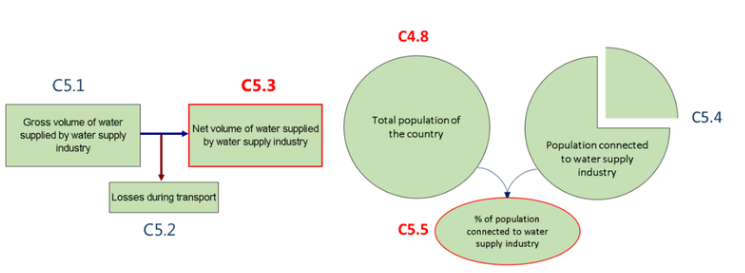
Units and equations
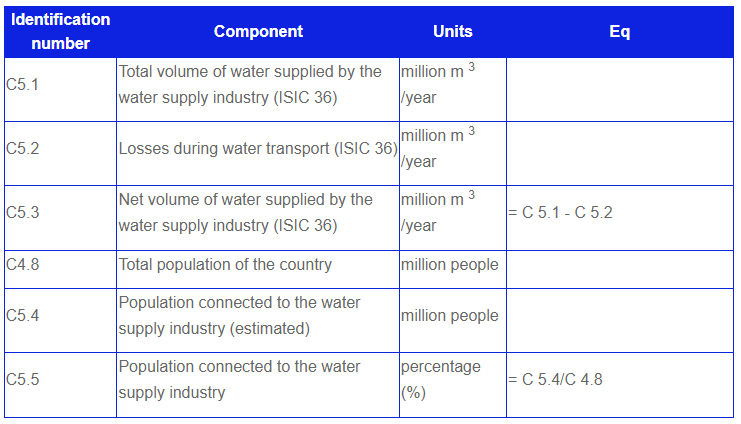
Gap filling methodology
No gap filling has been done.
Methodological references
- EEA, 2005. Guidance on the EEA core set of Indicators. EEA Technical report No. 1/2005, ISBN 92-9167-757-4, Luxembourg.
- UNECE, 2018. Guidelines for the Implementation of Environmental Indicators, Data template – C5: Water supply industry and population connected to the water supply industry.
- UNECE, 2018. Guidelines for the Implementation of Environmental Indicators, Description of C5: The water supply industry and the population connected to the water supply industry.
- UNECE, 2018. Guidelines for the Application of Environmental Indicators, Glossary of Terms – C5: Water supply industry and population connected to the water supply industry.
- UNSD and UNEP, 2013. Environmental Statistics Survey 2013. United Nations Statistics Division and United Nations Environment Programme, Environmental Statistics Survey 2013, Water Division.
Uncertainties
Methodological uncertainties
No ambiguity was detected.
Uncertainties in data
No ambiguity was detected.
Ambiguities in reasoning
No ambiguity was detected.
Information sources
-
The information was presented by the State Statistics Committee of the Republic of Azerbaijan within the framework of the activities of the AQTA PEIS II East project. However, some information can be obtained from the sources given below:
- 1. The main indicators characterizing the protection of water resources and their efficient use were presented by the State Statistics Committee of the Republic of Azerbaijan.
3. The main indicators characterizing water resources by types of economic activity were presented by the State Statistics Committee of the Republic of Azerbaijan.
MetadataThemes: water
Indicator code: C5
Tags: water supply, population connected to water supply, water losses, Azerbaijan
Time period covered: 2000-2017
DPSIR: Pressure
Typology: descriptive indicator (Type A - what is happening to the environment and people?)
DatesPublication date:
Last modified:
Frequency of updates: yearly
Contact information and ownershipContact person:
Ownership: State Statistics Committee of the Republic of Azerbaijan
Related content
Short term work
No short-term jobs have been identified.
Long term work
The National Water Strategy is being developed.
